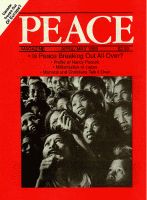
Peace Magazine Apr-May 1989, page 14. Some rights reserved.
Search for other articles by Tim Draimin here
Search for other articles by Liisa North here
The Esquipulas II Accord, signed by the five Central American heads of state on August 7, 1987, was a remarkable achievement. By recognizing the legitimacy of all the existing regional governments and calling on the U.S. to stop aiding the contras, that agreement represented a major step to reduce inter-state conflict. It also opened political space in the region by calling for national reconciliation and dialogue with opposition forces, and the repatriation of refugees. By mid-1987, some 200,000 people had died in the conflicts in El Salvador, Guatemala and Nicaragua, two million people had been forced to flee their homes, and the region's economies lay in shambles.
Since the signing of the Accord, significant but uneven progress toward peace has been made. Reviewing the compliance records of the five countries, Nicaragua's stands out favorably. Most emergency restrictions on civil and political liberties, and on the press, introduced in 1982 as a consequence of the contra war, have been lifted. The most prestigious opposition figure, the Archbishop of Managua, was named to the National Reconciliation Commission. And a cease fire, which has held, was negotiated with the contras as the U.S Congress cut off military assistance to them.
Compliance elsewhere in the region has been slow and, for the most part, superficial. This can be explained by dependency on the pressure from the United States and also by the correlation of internal civilian and military political forces. While the attitudes of Central American political, military and business elites toward the Sandinista Revolution are not favorable on the whole, they have manifested at least a grudging willingness to live with the new regime in Nicaragua. The contras' and Nicaragua's border conflicts with Honduras and Costa Rica would not have emerged, or at least not in the way they did, had it not been for the militaristic policies of the Reagan administration. However, business elites and military establishments have not changed their positions on negotiations with insurgents, or on the land and other reforms required for establishing a durable peace.
Thus in El Salvador and especially, Guatemala, the internal political changes agreed to in Esquipulas II have not materialized. National Reconciliation Commissions were established, but human rights abuses remained frequent or even increased, and conversations with armed opposition groups have not progressed, due to the opposition of the military and extreme right wing civilian parties. Military establishments, it must be stressed, have been strengthened during civil war (the size of the region's armed forces had tripled to almost 200,000 by 1986). Although the military no longer rule formally, they do exercise effective veto power over their civilian governments. Moreover, in the case of El Salvador, a green light from the United States is required for negotiating a modus vivendi with the armed opposition.
To place the dilemma faced by Honduras into perspective, although the country's armed forces have grown to 24,000, the contras operating from its territory numbered 6,000 to 12,000. Hence Honduras could hardly proceed to dismantling contra bases without cooperation from Washington. For Costa Rica, of course, compliance did not pose major internal or international problems other than those deriving from increased tension in its relations with the United States.
Thus conflicts continue but opportunities to promote peace are also present. Perhaps most importantly, it appears that the Bush administration will drop the contra option, although possibilities of substantive rapprochement with Nicaragua remain unclear. Sensing Washington's policy shift, in late November 1988,the Central Americans asked the United Nations to initiate the establishment of a verification commission to monitor the international provisions of the Accord. The request was reaffirmed in the heads of state meeting of February 1989. However, no progress was made at that meeting toward the resolution of internal conflicts in El Salvador and Guatemala.
Also the debit side, the International Commission for Verification and Control, established in the Accord for monitoring compliance, has not been reinstated. Representing the Secretaries General of the United Nations and the Organization of American States, together with the foreign ministers of the Central American and Contadora and Support Group countries, the Commission was dissolved in January 1988 when it tabled a compliance report considered too favorable to Nicaragua by U.S allies El Salvador, Guatemala, and Honduras. Moreover, the Accord left the critical issues of arms reductions and demilitarization to future negotiations, and these have not gotten off the ground.
In sum, we cannot expect smooth progress toward peace in Central America, although possibilities have opened up significantly since the signing of the Accord.
The authors are Political Scientists at York University.

Peace Magazine Apr-May 1989, page 14. Some rights reserved.
Search for other articles by Tim Draimin here
Search for other articles by Liisa North here